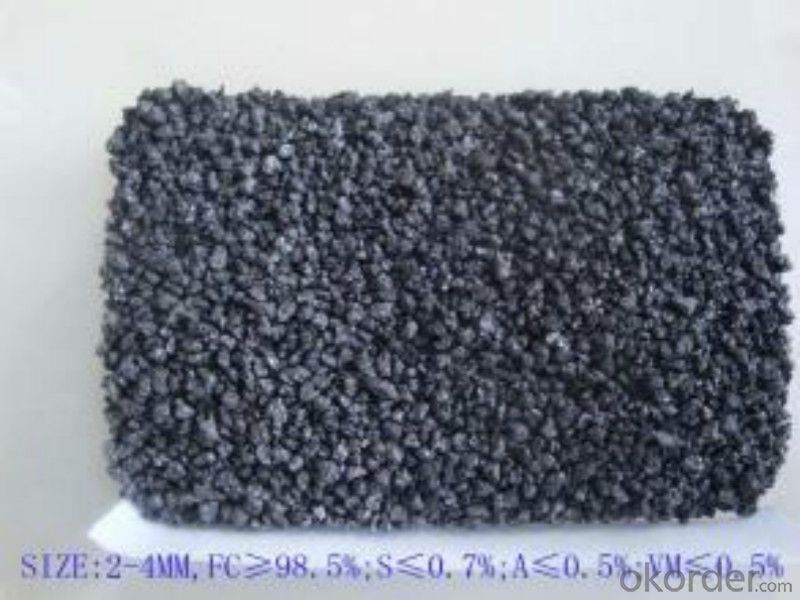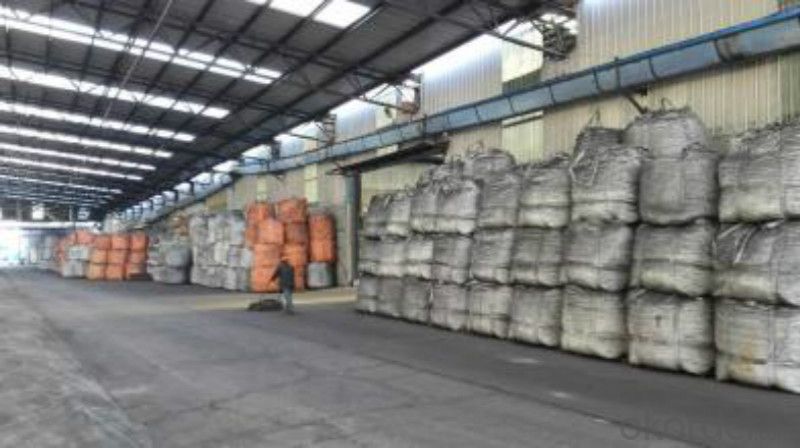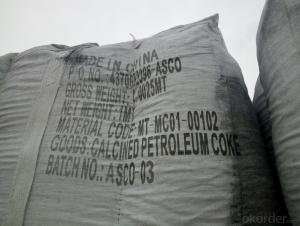Calcined Pitch Coke with Ash 0.5 percent max used as Carbon Raiser
- Loading Port:
- Tianjin
- Payment Terms:
- TT OR LC
- Min Order Qty:
- 21 m.t.
- Supply Capability:
- 8000 m.t./month
OKorder Service Pledge
OKorder Financial Service
You Might Also Like
Introduction
Pitch Coke/Coal Tar Pitch is a kind of black brittleness and blocky piece, lustrously at normal temperature. It has special odour and poisonous and can be easily flame when melting, second-grade inflammable solid.
Pitch Coke/Coal Tar Pitch is obtained from powerfully processed coal tar. Compared to petroleum asphalt, the adhesiveness is better. Coal Tar Pitch is high quality tar production with high fixed carbon. It has excellent adhesion, waterproofing and resistance against seawater, oil and various chemicals. In these properties, it is much better than petroleum asphalt tar.
It can be used to produce painting, electrode, pitch coke, and tar felt. It also can be used as fuel and the raw material of asphalt carbon black.
Features:
The morphology, chemistry and crystallinity of recarburisers have a major impact on the overall casting cost. The combined application and cost benefits, which are derived through the use of Desulco, enable foundries to manufacture castings in a highly cost effective manner.
reduces
Recarburiser consumption
Power consumption
Inoculant consumption
MgFeSi consumption
Furnace refractory wear
Scrap rate
Tap to tap time
Slag inclusions risk
Chill
increases
Casting microstructure
Productivity
Process consistency
Carbon Recovery
Compared with calcined petroleum coke, acetylene coke and
graphite electrode scrap, Desulco yields the highest carbon
recovery and fastest dissolution time
Specifications:
CPC | |||
F.C.% | 98.5MIN | 98.5MIN | 98MIN |
ASH % | 0.8MAX | 0.8MAX | 1MAX |
V.M.% | 0.7 MAX | 0.7 MAX | 1 MAX |
SULFUR % | 0. 5MAX | 0. 7MAX | 1MAX |
MOISTURE % | 0.5MAX | 0.5MAX | 1MAX |
Pictures:




FAQ:
1.MOQ:2 Containers |
2.Size:1-3mm,1-5mm,2-6mm,3-5mm and as the customer's requirement |
3.Packing: 1 ton jumbo bag or 25kgs paper in bag |
4.Payment:T/T or L/C at sight |
5.Delivery time: within 15 days after receiving the deposit |
6.Usage: it is as carbon raiser,widely used in steelmaking,casting,casting iron,steel foundry,aluminum metallury. |
- Q:Are carbon fibers organic polymer materials?
- No, carbon fiber is not an organic polymer material, and carbon fiber is an inorganic polymer materialOrganic polymer compounds referred to as polymer compound or polymer, also known as polymer is composed of one or several structural units repeatedly (103~105) compound repeat connected. Their elements are not many, mainly carbon, hydrogen, oxygen and nitrogen, but the molecular weight is large, generally above 10000, high millions.
- Q:What is carbon nanoelectronics?
- Carbon nanoelectronics refers to the field of research and development that focuses on utilizing carbon-based materials, such as carbon nanotubes or graphene, for the creation and advancement of electronic devices and components on a nanoscale level. These nanoscale carbon structures possess unique electrical properties that make them highly desirable for applications in a wide range of electronic devices, including transistors, sensors, and interconnects. One of the key advantages of carbon nanoelectronics is the exceptional electrical conductivity and thermal properties of carbon nanomaterials. Carbon nanotubes, for instance, exhibit excellent electrical conductivity, comparable to copper, but with a much smaller footprint. This property allows for the creation of smaller and more efficient electronic devices, leading to advancements in areas such as miniaturization and energy efficiency. Another noteworthy aspect of carbon nanoelectronics is the immense strength and flexibility of carbon nanomaterials. Carbon-based structures like graphene possess exceptional mechanical properties, making them highly durable and resilient. This property enables the production of flexible and wearable electronic devices that can conform to various surfaces, opening up new possibilities for electronics design and integration. Additionally, carbon nanoelectronics offers the potential for high-speed and low-power electronic devices. The unique electronic properties of carbon nanomaterials, such as their ability to carry electric charge at an extremely high speed, make them suitable for high-frequency applications. Furthermore, the low power consumption of carbon nanomaterials can lead to the development of energy-efficient electronic devices. Overall, carbon nanoelectronics holds great promise for revolutionizing the field of electronics by enabling the creation of smaller, faster, and more energy-efficient devices. Continued research and development in this field are expected to lead to breakthroughs in various industries, including computing, telecommunications, healthcare, and energy.
- Q:What are the limitations of carbon dating?
- Carbon dating, also known as radiocarbon dating, is a widely used method for determining the age of organic materials up to 50,000 years old. While it has revolutionized the field of archaeology and paleontology, it does have certain limitations that researchers must be aware of. One limitation of carbon dating is its inability to accurately date materials beyond the 50,000-year mark. This is due to the fact that carbon-14, the isotope used in carbon dating, has a half-life of only 5,730 years. As a result, after several half-lives, there is not enough carbon-14 remaining in a sample to accurately determine its age. Another limitation is the reliance on organic material. Carbon dating can only be used on organic materials such as bones, shells, wood, and charcoal. This means that it is not applicable to inorganic materials like rocks or minerals. Additionally, the presence of certain contaminants in the sample, such as humic acids or carbonates, can distort the carbon dating results. Furthermore, carbon dating is limited by the fact that it can only provide a relative age for the sample. It determines the ratio of carbon-14 to carbon-12 in the sample and compares it to the known ratio in the atmosphere. By assuming that the ratio has remained constant over time, an estimate of the sample's age can be made. However, variations in the atmospheric carbon-14 levels over time can affect the accuracy of this method. Additionally, carbon dating can be influenced by the presence of nuclear testing and other human activities that have released significant amounts of carbon-14 into the atmosphere. This is known as the "bomb effect" and can result in artificially younger dates for samples collected after the mid-20th century. Lastly, carbon dating can be limited by the size and condition of the sample. In order to obtain accurate results, a sufficient amount of organic material is required for analysis. This can be challenging when dealing with small or degraded samples, as the carbon-14 content may be insufficient or contaminated. In conclusion, while carbon dating is a valuable tool for determining the age of organic materials, it does have certain limitations. Researchers must consider these limitations and be cautious when interpreting the results, taking into account the age range, sample type, presence of contaminants, atmospheric variations, and sample size.
- Q:How does carbon impact the energy balance of the Earth?
- Carbon impacts the energy balance of the Earth primarily through its role in the greenhouse effect. Carbon dioxide (CO2), a greenhouse gas, is released into the atmosphere through natural processes and human activities such as burning fossil fuels and deforestation. The greenhouse effect is a natural process where certain gases in the atmosphere trap heat from the sun, preventing it from escaping back into space. This process helps maintain a suitable temperature for life on Earth. However, excessive carbon emissions have enhanced the greenhouse effect, leading to global warming and climate change. When carbon dioxide and other greenhouse gases accumulate in the atmosphere, they trap more heat, causing the Earth's surface temperature to rise. This rise in temperature disrupts the energy balance of the planet. It contributes to the melting of polar ice caps, rising sea levels, and more frequent and severe extreme weather events. Furthermore, carbon affects the energy balance of the Earth by altering the carbon cycle. The carbon cycle is a natural process in which carbon is exchanged between the atmosphere, oceans, and land. However, human activities have significantly disrupted this cycle by releasing large amounts of carbon into the atmosphere, primarily through the burning of fossil fuels. Excessive carbon emissions result in an imbalance in the carbon cycle, as the natural processes that absorb and store carbon, such as photosynthesis and the ocean's ability to absorb CO2, cannot keep up with the pace of emissions. This leads to an accumulation of carbon dioxide in the atmosphere, further exacerbating the greenhouse effect and contributing to global warming. Overall, carbon significantly impacts the energy balance of the Earth by intensifying the greenhouse effect and disrupting the natural carbon cycle. It is crucial to reduce carbon emissions and transition to cleaner and more sustainable energy sources to mitigate the negative effects of carbon on the planet's energy balance and ultimately, preserve the health and stability of our environment.
- Q:What are the effects of carbon emissions on the Arctic ecosystem?
- The Arctic ecosystem is significantly impacted by carbon emissions, primarily due to global warming. The release of carbon dioxide and other greenhouse gases into the atmosphere traps heat, leading to increased temperatures worldwide. However, the Arctic is particularly susceptible to these effects because of its unique characteristics. One of the most noteworthy consequences of carbon emissions on the Arctic ecosystem is the rapid melting of ice. Increasing temperatures cause glaciers and ice sheets to decrease in size, resulting in the loss of habitat for ice-dependent species like polar bears, walruses, and seals. These animals not only depend on the ice for resting and breeding but also for hunting and finding food. The reduction of their natural habitat has led to a decline in their populations, impacting the delicate balance of the Arctic food chain. Moreover, the melting of ice leads to rising sea levels, which can have cascading effects on coastal areas. Many Arctic communities, including indigenous peoples, are located near the coast and rely on the sea for their livelihoods. The increase in erosion, flooding, and storm surges due to rising sea levels pose a threat to their homes, infrastructure, and traditional ways of life. Furthermore, carbon emissions contribute to ocean acidification, a process in which excess carbon dioxide absorption by seawater lowers its pH level. This acidification has detrimental effects on marine organisms such as shellfish, corals, and plankton, which struggle to build and maintain their calcium carbonate structures. These organisms serve as essential food sources for various Arctic species, including fish, seabirds, and marine mammals. The decline in their populations disrupts the intricate web of life in the Arctic and can have far-reaching consequences. Climate change caused by carbon emissions also disrupts the timing and patterns of seasonal events, such as plant growth, bird migration, and the availability of food resources. This mismatch can have severe consequences for species that rely on specific timing for reproduction, migration, and survival. In summary, the effects of carbon emissions on the Arctic ecosystem are significant and extensive. The loss of sea ice, rising sea levels, ocean acidification, and disrupted ecological processes all contribute to the vulnerability of Arctic species and communities. Urgent action to reduce carbon emissions, mitigate climate change, and protect this fragile ecosystem is crucial for the long-term preservation of the Arctic.
- Q:What are the challenges of carbon capture and storage technology?
- Carbon capture and storage (CCS) technology shows promise as a solution for reducing greenhouse gas emissions and combating climate change. Nevertheless, there are various obstacles that must be overcome in order for it to be widely adopted and effective. One of the primary hurdles associated with CCS technology is its considerable cost. The implementation of CCS necessitates significant investments in infrastructure, equipment, and operations, making it economically burdensome. Additionally, the capture process itself requires substantial amounts of energy, resulting in increased costs and potentially limiting its feasibility. Another challenge pertains to the limited capacity for storage. Identifying suitable underground sites for storing the captured carbon dioxide (CO2) is crucial, but can be difficult due to geological limitations. The task of identifying and evaluating suitable sites with adequate storage capacity is complex and necessitates meticulous planning. Furthermore, concerns exist regarding the long-term stability and integrity of the storage sites. Leakage of stored CO2 could compromise the effectiveness of CCS and pose environmental risks. Ensuring the secure and safe storage of captured carbon is essential to prevent any adverse impacts on ecosystems and public health. Transporting the captured CO2 from the capture sites to the storage facilities also presents a challenge. Establishing an efficient and extensive transportation infrastructure is necessary for the widespread implementation of CCS technology. Developing pipelines or other means of transportation capable of handling the volume of captured CO2 and ensuring its secure transport over long distances is crucial. Public acceptance and social factors also significantly impact the challenges associated with CCS technology. Local communities may have concerns and objections regarding potential risks associated with the capture, transport, and storage of CO2. Effectively addressing these concerns through transparent communication and engagement with stakeholders is vital for garnering public support and minimizing opposition. In conclusion, carbon capture and storage technology has the potential to greatly reduce greenhouse gas emissions. However, its challenges, including high costs, limited storage capacity, integrity concerns, transportation infrastructure, and public acceptance, must be addressed to ensure successful implementation and make a significant contribution to mitigating climate change.
- Q:What are the consequences of increased carbon emissions on global food security?
- Global food security is significantly impacted by increased carbon emissions, with a range of consequences. One immediate effect is the alteration of weather patterns and an increase in extreme weather events, such as droughts, floods, and heatwaves. These events can result in crop failures, reduced agricultural productivity, and the loss of livestock, ultimately leading to food shortages and price instability. In addition, carbon emissions contribute to climate change, which causes long-term shifts in temperature and precipitation patterns. Higher temperatures can accelerate the growth and reproduction rates of pests and diseases, posing a severe threat to crops and livestock. Furthermore, changes in rainfall patterns can disrupt the timing and quantity of water available for irrigation, further reducing agricultural productivity. Moreover, carbon emissions contribute to ocean acidification, negatively impacting marine ecosystems and the livelihoods of fishing and aquaculture communities. This can result in a decline in fish stocks, jeopardizing an essential source of protein and nutrition for millions of people. Increased carbon emissions also lead to the loss of biodiversity. Climate change disrupts ecosystems, leading to the extinction or migration of plant and animal species. This loss of biodiversity reduces the resilience and adaptability of agricultural systems, making them more susceptible to pests, diseases, and environmental pressures. Ultimately, the consequences of increased carbon emissions on global food security are extensive and intricate. They include diminished agricultural productivity, rising food prices, food shortages, and limited access to nutritious food. Addressing carbon emissions and mitigating climate change is vital to ensure a sustainable and secure global food system for future generations.
- Q:Process for producing carbon fiber board
- Carbon fiber forming process:1, pressing method. This method is put into the carbon fiber prepreg resin has the metal mold, the pressure of excess glue overflow, then high temperature curing, stripping the finished products come out, this method is the most suitable for production of auto parts.2, hand paste layer method. The impregnated carbon fiber sheets are cut or laminated, or so that the sides of the layer are brushed with resin and then pressed to form. This method can be used arbitrarily to select the direction, size and thickness of fibers and is widely used. Note that the shape of the layer is smaller than the shape of the mold, so that the fiber will not bend when it is pressed in the mold.3 、 vacuum bag hot pressing method. Laminated on the mold hill and covered with heat-resistant film, applying pressure from the soft pocket to the laminate and curing in hot pressing.4, winding forming method. The carbon fiber monofilament is wound on the carbon fiber shaft, and is especially suitable for making cylindrical and hollow containers.5, pultrusion. The carbon fiber is fully infiltrated, and the resin and air are removed by extrusion, then solidified in the furnace. The method is simple and suitable for preparing rod shaped and tubular parts.
- Q:Can carbon in barbecue cause cancer? Can carbonated food cause cancer?
- Eat barbecue are carcinogenic, because the meat directly on the heat under the grill, the decomposition of fat droplets in the charcoal, and then with the meat proteins, it will produce a carcinogen called benzopyrene. Experts explained that if people regularly eat food contaminated by benzopyrene, carcinogens can accumulate in the body and cause stomach cancer and bowel cancer.
- Q:What is the carbon content of 45# steel?
- Between 0.42- and zero point five zero percent per cent
1. Manufacturer Overview |
|
|---|---|
| Location | |
| Year Established | |
| Annual Output Value | |
| Main Markets | |
| Company Certifications | |
2. Manufacturer Certificates |
|
|---|---|
| a) Certification Name | |
| Range | |
| Reference | |
| Validity Period | |
3. Manufacturer Capability |
|
|---|---|
| a)Trade Capacity | |
| Nearest Port | |
| Export Percentage | |
| No.of Employees in Trade Department | |
| Language Spoken: | |
| b)Factory Information | |
| Factory Size: | |
| No. of Production Lines | |
| Contract Manufacturing | |
| Product Price Range | |
Send your message to us
Calcined Pitch Coke with Ash 0.5 percent max used as Carbon Raiser
- Loading Port:
- Tianjin
- Payment Terms:
- TT OR LC
- Min Order Qty:
- 21 m.t.
- Supply Capability:
- 8000 m.t./month
OKorder Service Pledge
OKorder Financial Service
Similar products
New products
Hot products
Related keywords




























